Carbon Microstructures Synthesis in Low Temperature Plasma Generated by Microdischarges
Abstract
1. Introduction
2. Materials and Methods
3. Results
3.1. Discharge Modes
3.2. Discharge Diagnostics by OES
3.3. Carbon Deposit
3.4. Carbon Aerosol Produced in the Discharge
4. Conclusions
Author Contributions
Funding
Institutional Review Board Statement
Informed Consent Statement
Data Availability Statement
Acknowledgments
Conflicts of Interest
References
- Huczko, A. Synthesis of aligned carbon nanotubes. Appl. Phys. A 2002, 74, 617–638. [Google Scholar] [CrossRef]
- Tachibana, K. Current status of microplasma research. IEEJ Trans. Electr. Electron. Eng. 2006, 1, 145–155. [Google Scholar] [CrossRef]
- Martynov, Y.P.; Ivanov, V.A. Microdischarge of conducting particles and breakdown of a vacuum gap. Radio Eng. Electron. Phys. 1969, 14, 1732–1737. [Google Scholar]
- Hara, M.; Akazaki, M. Analysis of microdischarge threshold conditions between a conducting sphere and plate. J. Electrostat. 1982, 13, 105–118. [Google Scholar] [CrossRef]
- Gherardi, N.; Martin, S.; Massines, F. A new approach to SiO2 deposit using a N2 –SiH4 –N2O glow dielectric barri-er-controlled discharge at atmospheric pressure. J. Phys. D Appl. Phys. 2000, 33, L104–L108. [Google Scholar] [CrossRef]
- Shirai, H.; Kobayashi, T.; Hasegawa, Y. Synthesis of silicon nanocones using rf microplasma at atmospheric pressure. Appl. Phys. Lett. 2005, 87, 143112. [Google Scholar] [CrossRef]
- Kozak, D.; Shibata, E.; Iizuka, A.; Nakamura, T. Growth of carbon dendrites on cathode above liquid ethanol using surface plasma. Carbon 2014, 70, 87–94. [Google Scholar] [CrossRef]
- Kikuchi, T.; Hasegawa, Y.; Shirai, H. Rf microplasma jet at atmospheric pressure: Characterization and application to thin film processing. J. Phys. D Appl. Phys. 2004, 37, 1537–1543. [Google Scholar] [CrossRef]
- Brock, J.R.; Lim, P. Formation of carbon fibers in corona discharges. Appl. Phys. Lett. 1991, 58, 1259–1261. [Google Scholar] [CrossRef]
- Danilaev, M.P.; Bogoslov, E.A.; Morozov, O.G.; Nasybullin, A.; Pashin, D.M.; Pol′skii, Y.E. Obtaining Carbon Dendrites from the Products of Conversion of Polymer Materials. J. Eng. Phys. Thermophys. 2015, 88, 774–780. [Google Scholar] [CrossRef]
- Li, M.-W.; Hu, Z.; Wang, X.-Z.; Wu, Q.; Chen, Y.; Tian, Y.-L. Low-temperature synthesis of carbon nanotubes using corona discharge plasma at atmospheric pressure. Diam. Relat. Mater. 2004, 13, 111–115. [Google Scholar] [CrossRef]
- Sano, N.; Nobuzawa, M. Icicle-like carbon nanotubes forest at tungsten wire tip formed by high-voltage corona discharge. Carbon 2005, 43, 2224–2226. [Google Scholar] [CrossRef]
- Mesko, M.; Vretenar, V.; Kotrusz, P.; Hulman, M.; Soltys, J.; Skaklaowa, V. Carbon nanowalls synthesis by means of at-mospheric dcPECVD method. Phys. Status Solidi B 2012, 249, 2625–2628. [Google Scholar] [CrossRef]
- Sobczyk, A.; Rajch, E.; Sozańska, M.; Jaworek, A. Formation of Carbon Fibres in High-Voltage Low-Current Electrical Discharges. Solid State Phenom. 2008, 140, 103–108. [Google Scholar] [CrossRef]
- Sobczyk, A.T.; Jaworek, A. Carbon structures formation in low current high voltage electrical discharge in hydrocarbon vapours. J. Phys. Conf. Ser. 2011, 301, 012023. [Google Scholar] [CrossRef]
- Yang, Q.; Wu, J.; Li, S.; Zhang, L.; Fu, J.; Huang, F.; Cheng, Q. Vertically-oriented graphene nanowalls: Growth and application in Li-ion batteries. Diam. Relat. Mat. 2019, 91, 54–63. [Google Scholar] [CrossRef]
- Pierpaoli, M.; Jakobczyk, P.; Sawczak, M.; Łuczkiewicz, A.; Fudala-Książek, S.; Bogdanowicz, R. Carbon nanoarchitectures as high-performance electrodes for the electrochemical oxidation of landfill leachate. J. Hazard. Mater 2021, 401, 123407. [Google Scholar] [CrossRef]
- Lee, J.-S.; Joh, H.-I.; Kim, T.-W.; Lee, S. Carbon nanosheets derived from soluble pitch molecules and their applications in organic transistors. Org. Electron. 2014, 15, 132–138. [Google Scholar] [CrossRef]
- Lehmann, K.; Yurchenko, O.; Melke, J.; Fischer, A.; Urban, G. High electrocatalytic activity of metal-free and non-doped hierarchical carbon nanowalls towards oxygen reduction reaction. Electrochim. Acta 2018, 269, 657–667. [Google Scholar] [CrossRef]
- Bae, I.-S.; Cho, S.-H.; Park, Z.T.; Kim, J.-G.; Boo, J.H. Organic polymer thin films deposited on silicon and copper by plasma-enhanced chemical vapor deposition method and characterization of their electrochemical and optical properties. J. Vac. Sci. Technol. A 2005, 23, 875. [Google Scholar] [CrossRef]
- Antony, A.; Seo, H.J.; Boo, J. Plasma-polymerized cyclohexane coatings for ethanol and ammonia vapors sensing. Asia-Pacif. J. Chem. Eng. 2020, 15, 2452. [Google Scholar] [CrossRef]
- Son, H.H.; Park, J.N.; Lee, W.G. Hydrophobic properties of films grown by torch-type atmospheric pressure plasma in Ar ambient containing C6 hydrocarbon precursor. Korean J. Chem. Eng. 2013, 30, 1480–1484. [Google Scholar] [CrossRef]
- Huang, C.; Yu, Q.; Wu, S.-Y. Influence of the luminous gas phase on direct current plasma polymerized hydrocarbon film growth. Vaccum 2010, 84, 1402–1406. [Google Scholar] [CrossRef]
- Sigmond, R.S. Simple approximate treatment of unipolar space-charge-dominated coronas: The Warburg law and the saturation current. J. Appl. Phys. 1982, 53, 891–898. [Google Scholar] [CrossRef]
- Tachibana, K.; Koshiishi, T.; Furuki, T.; Ichiki, R.; Kanazawa, S.; Sato, T.; Mizeraczyk, J. A new measurement method of DC corona-discharge characteristics using repetitive ramp and triangular voltages. J. Electrost. 2020, 108, 103525. [Google Scholar] [CrossRef]
- Goldman, M.; Sigmond, R.S. The corona discharge, its properties and specific uses. Pure Appl. Chem. 1985, 57, 1353–1362. [Google Scholar] [CrossRef]
- Yanallah, K.; Pontiga, F. A semi-analytical stationary model of a point-to-plane corona discharge. Plasma Sources Sci. Technol. 2012, 21, 045007. [Google Scholar] [CrossRef]
- Takaki, K.; Kitamura, D.; Fujiwara, T. Characteristics of a high-current transient glow discharge in dry air. J. Phys. D Appl. Phys. 2000, 33, 1369–1375. [Google Scholar] [CrossRef]
- Titov, V.A.; Rybkin, V.V.; Maximov, A.I.; Choi, H.-S. Characteristics of Atmospheric Pressure Air Glow Discharge with Aqueous Electrolyte Cathode. Plasma Chem. Plasma Process. 2005, 25, 503–518. [Google Scholar] [CrossRef]
- Pai, D.Z.; Lacoste, D.A.; Laux, C. Transitions between corona, glow, and spark regimes of nanosecond repetitively pulsed discharges in air at atmospheric pressure. J. Appl. Phys. 2010, 107, 093303. [Google Scholar] [CrossRef]
- Hao, Y.; Zheng, B.; Liu, Y. Cathode fall measurement in a dielectric barrier discharge in helium. Phys. Plasmas 2013, 20, 113510. [Google Scholar] [CrossRef]
- Fuge, R.; Liebscher, M.; Schröfl, C.; Damm, C.; Eckert, V.; Eibl, M.; Leonhardt, A.; Büchner, B.; Mechtcherine, V. Influence of different hydrocarbons on the height of MWCNT carpets: Role of catalyst and hybridization state of the carbon precursor. Diam. Relat. Mat. 2018, 90, 18–25. [Google Scholar] [CrossRef]
- Jiao, C.Q.; Adams, S.F. Electron ionization of selected cyclohexanes. J. Phys. B At. Mol. Opt. Phys. 2011, 44, 175209. [Google Scholar] [CrossRef]
- Kramida, A.; Ralchenko, Y.; Reader, J. NIST ASD Team. NIST Atomic Spectra Database (Version 5.8); National Institute of Standards and Technology: Gaithersburg, MD, USA, 2019. Available online: https://physics.nist.gov/asd (accessed on 30 April 2021).
- Pearse, R.W.B.; Gaydon, A.G. The Identification of Molecular Spectra, 3rd ed.; Chapman and Hall: London, UK, 1976. [Google Scholar]
- Treshchalov, A.B.; Lissovski, A.A. VUV–VIS spectroscopic diagnostics of a pulsed high-pressure discharge in argon. J. Phys. D Appl. Phys. 2009, 42, 245203. [Google Scholar] [CrossRef]
- Fantz, U.; Meir, S.; ASDEX Upgrade Team. Correlation of the intensity ratio of C2/CH molecular bands with the flux ratio of C2Hy/CH4 particles. J. Nucl. Mater. 2005, 337–339, 1087–1091. [Google Scholar] [CrossRef]
- Catherine, Y.; Pastol, A.; Athouel, L.; Fourrier, C. Diagnostics of CH, plasmas carbon deposition used for diamond-like carbon deposition. IEEE Trans. Plasma Sci. 1990, 18, 923–929. [Google Scholar] [CrossRef]
- Gordillo-Vázquez, F.J.; Albella, J.M. Influence of the pressure and power on the non-equilibrium plasma chemistry of C2, C2H, C2H2, CH3 and CH4 affecting the synthesis of nanodiamond thin films from C2H2 (1%)/H2/Ar-rich plasmas. Plasma Sources Sci. Technol. 2004, 13, 50–57. [Google Scholar] [CrossRef]
- Zhu, X.M.; Pu, Y.K.; Balcon, N.; Boswell, R. Measurement of the electron density in atmospheric-pressure low-temperature argon discharges by line-ratio method of optical emission spectroscopy. J. Phys. D Appl. Phys. 2009, 42, 142003. [Google Scholar] [CrossRef]
- Bashir, M.; Rees, J.M.; Bashir, S.; Zimmerman, W.B. Characterization of atmospheric pressure microplasma produced from argon and a mixture of argon–ethylenediamine. Phys. Lett. A 2014, 378, 2395–2405. [Google Scholar] [CrossRef]
- Messier, R.; Giri, A.P.; Roy, R.A. Revised structure zone model for thin film physical structure. J. Vac. Sci. Technol. A 1984, 2, 500–503. [Google Scholar] [CrossRef]
- Ren, Y.; Xu, S.; Rider, A.E.; Ostrikov, K. (Ken) Made-to-order nanocarbons through deterministic plasma nanotechnology. Nanoscale 2010, 3, 731–740. [Google Scholar] [CrossRef] [PubMed][Green Version]
- Michelmore, A.; Whittle, J.D.; Bradley, J.; Short, R.D. Where physics meets chemistry: Thin film deposition from reactive plasmas. Front. Chem. Sci. Eng. 2016, 10, 441–458. [Google Scholar] [CrossRef]
- Lia, S.G.; Levin, R.D.; Kafafi, S.A. Gas Phase Ion Energetics Data. NIST Chemistry WebBook, NIST Standard Reference Database Number 69; National Institute of Standards and Technology: Gaithersburg, MD, USA, 2018. Available online: https://webbook.nist.gov (accessed on 30 April 2021).
- McNaught, A.D.; Wilkinson, A.; IUPAC. Compendium of Chemical Terminology, 2nd ed.; Blackwell Scientific Publications: Oxford, UK, 1997. [Google Scholar]
- Castro, M.; Cuerno, R.; Nicoli, M.; Vázquez, L.; Buijnsters, J. Universality of cauliflower-like fronts: From nanoscale thin films to macroscopic plants. New J. Phys. 2012, 14, 103039. [Google Scholar] [CrossRef]
- Meier, M.; Von Keudell, A.; Jacob, W. Consequences of the temperature and flux dependent sticking coefficient of methyl radicals for nuclear fusion experiments. Nucl. Fusion 2002, 43, 25–29. [Google Scholar] [CrossRef]
- Reich, S.; Thomsen, C. Raman spectroscopy of graphite. Philos. Trans. R. Soc. 2004, 362, 2271–2288. [Google Scholar] [CrossRef]
- Ramya, K.; Jerin, J.; Manoy, B. Raman Spectroscopy Investigation of Camphor Soot: Spectral Analysis and Structural Information. Int. J. Electrochem. Sci. 2013, 8, 9421–9428. [Google Scholar]
- Ivleva, N.P.; McKeon, U.; Niessner, R.; Pöschl, U. Raman Microspectroscopic Analysis of Size-Resolved Atmospheric Aerosol Particle Samples Collected with an ELPI: Soot, Humic-Like Substances, and Inorganic Compounds. Aerosol Sci. Technol. 2007, 41, 655–671. [Google Scholar] [CrossRef]
- Wei, Q.; Ashfold, M.N.; Mankelevich, Y.; Yu, Z.; Liu, P.; Ma, L. Diamond growth on WC-Co substrates by hot filament chemical vapor deposition: Effect of filament–substrate separation. Diam. Relat. Mater. 2011, 20, 641–650. [Google Scholar] [CrossRef]
- Iwaki, M.; Watanabe, H.; Matsunaga, M.; Terashima, K. Synthesis of diamond-like carbon structure by Naion implantation in graphite and polyacetylene. Surf. Coat. Technol. 1998, 103–104, 370–374. [Google Scholar] [CrossRef]
- Chu, P.K.; Li, L. Characterization of amorphous and nanocrystalline carbon films. Mater. Chem. Phys. 2006, 96, 253–277. [Google Scholar] [CrossRef]
- Wopenka, B.; Xu, Y.; Zinner, E.; Amari, S. Murchison presolar carbon grains of different density fractions: A Raman spectroscopic perspective. Geochim. Cosmochim. Acta 2013, 106, 463–489. [Google Scholar] [CrossRef]
- Nakao, S.; Choi, J.; Kim, J.; Miyagawa, S.; Miyagawa, Y.; Ikeyama, M. Effects of positively and negatively pulsed voltages on the microstructure of DLC films prepared by bipolar-type plasma based ion implantation. Diam. Relat. Mater. 2006, 15, 884–887. [Google Scholar] [CrossRef]
- Yoshikawa, M.; Katagiri, G.; Ishida, H.; Ishitani, A.; Akamatsu, T. Raman spectra of diamondlike amorphous carbon films. J. Appl. Phys. 1988, 64, 6464–6468. [Google Scholar] [CrossRef]
- McConnell, M.L.; Dowling, D.P.; Pope, C.; Donnelly, K.; Ryder, A.G.; O’Connor, G.M. High pressure diamond and dia-mond-like carbon deposition using a microwave CAP reactor. Diam. Relat. Mat. 2002, 11, 1036–1040. [Google Scholar] [CrossRef]
- Ferrari, A.C.; Robertson, J.; Ferrari, A.C.; Robertson, J. Interpretation of Raman spectra of disordered and amorphous carbon. Phys. Rev. B 2000, 61, 14095–14107. [Google Scholar] [CrossRef]
- Shigeta, M.; Murphy, A. Thermal plasmas for nanofabrication. J. Phys. D Appl. Phys. 2011, 44, 174025. [Google Scholar] [CrossRef]
- Kouprine, A.; Gitzhofer, F.; Boulos, M.; Fridman, A. Polymer-Like C:H Thin Film Coating of Nanopowders in Capacitively Coupled RF Discharge. Plasma Chem. Plasma Process. 2004, 24, 189–215. [Google Scholar] [CrossRef]
- De Bleecker, K.; Bogaerts, A.; Goedheer, W. Detailed modeling of hydrocarbon nanoparticle nucleation in acetylene discharges. Phys. Rev. E. 2006, 73, 026405. [Google Scholar] [CrossRef]
- Van De Wetering, F.M.J.H.; Beckers, J.; Kroesen, G.M.W. Anion dynamics in the first 10 milliseconds of an argon–acetylene radio-frequency plasma. J. Phys. D Appl. Phys. 2012, 45, 485205. [Google Scholar] [CrossRef]


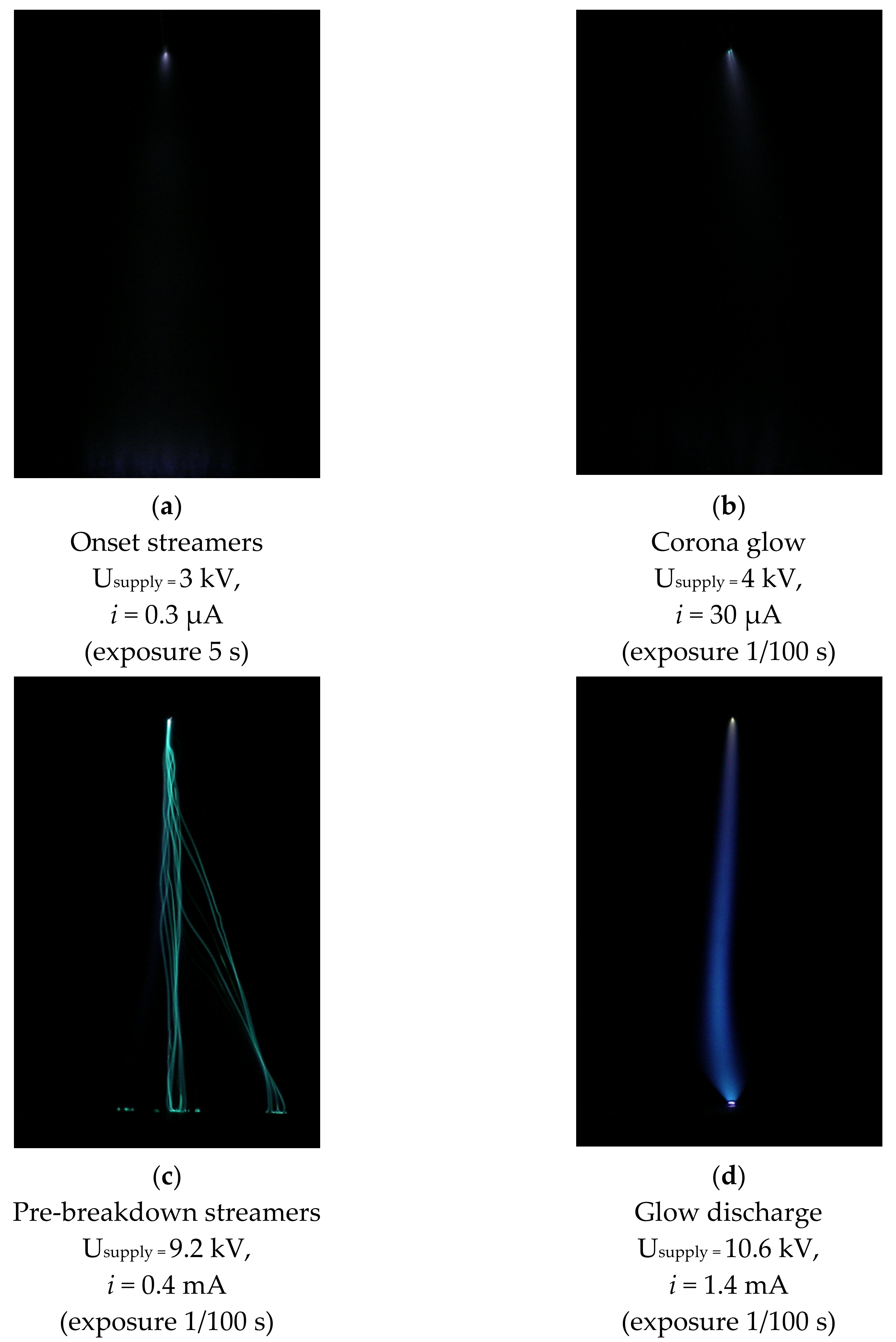
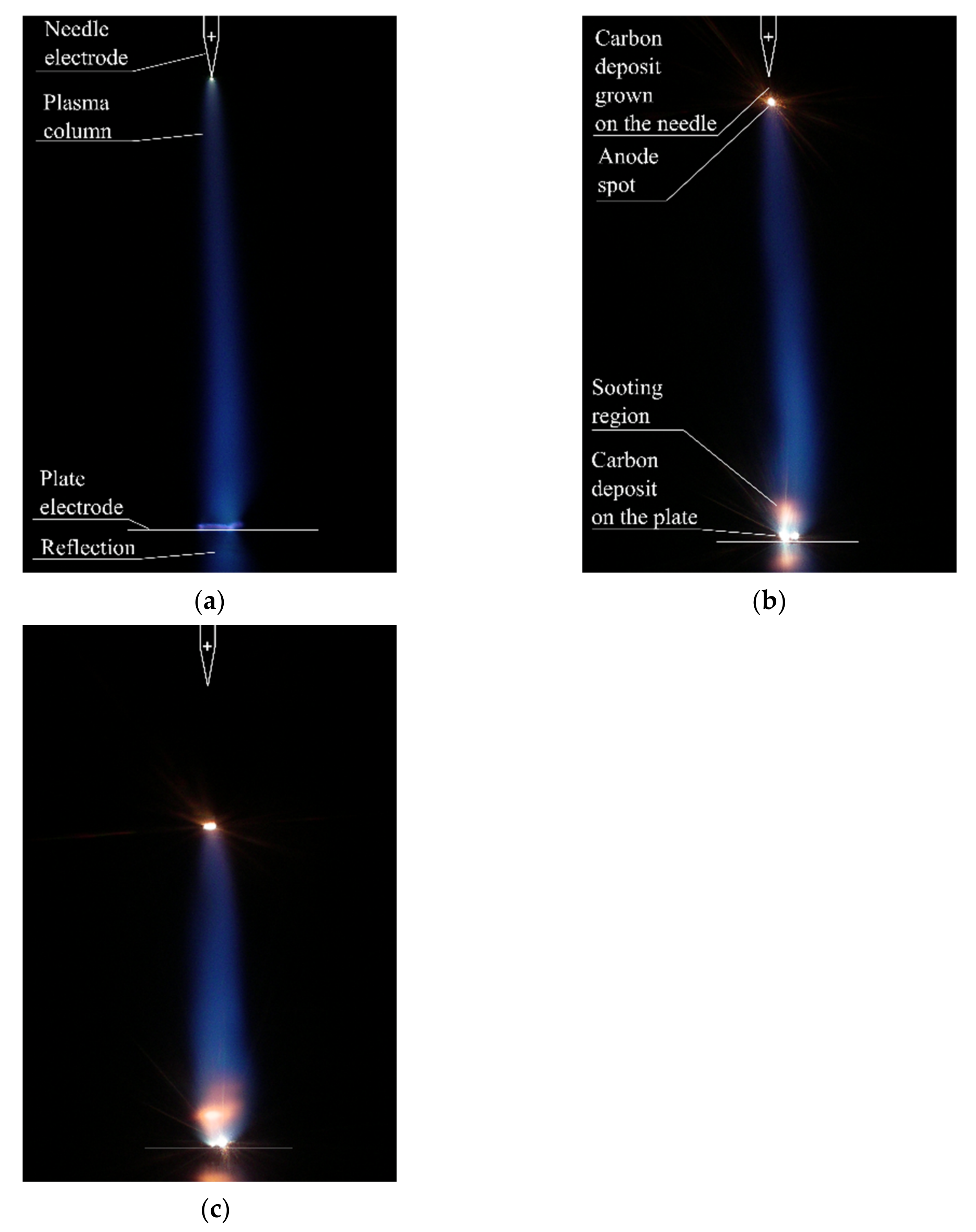


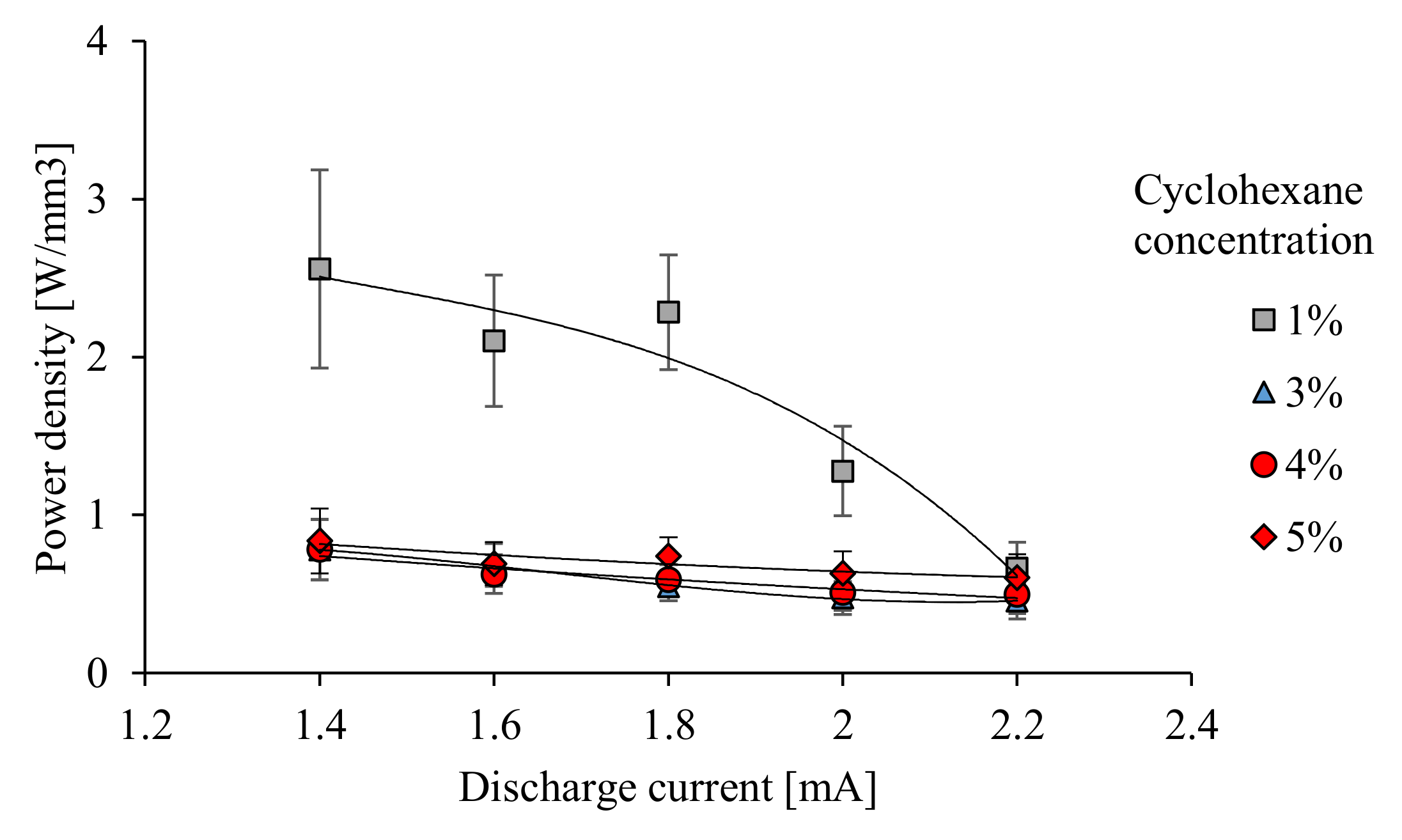

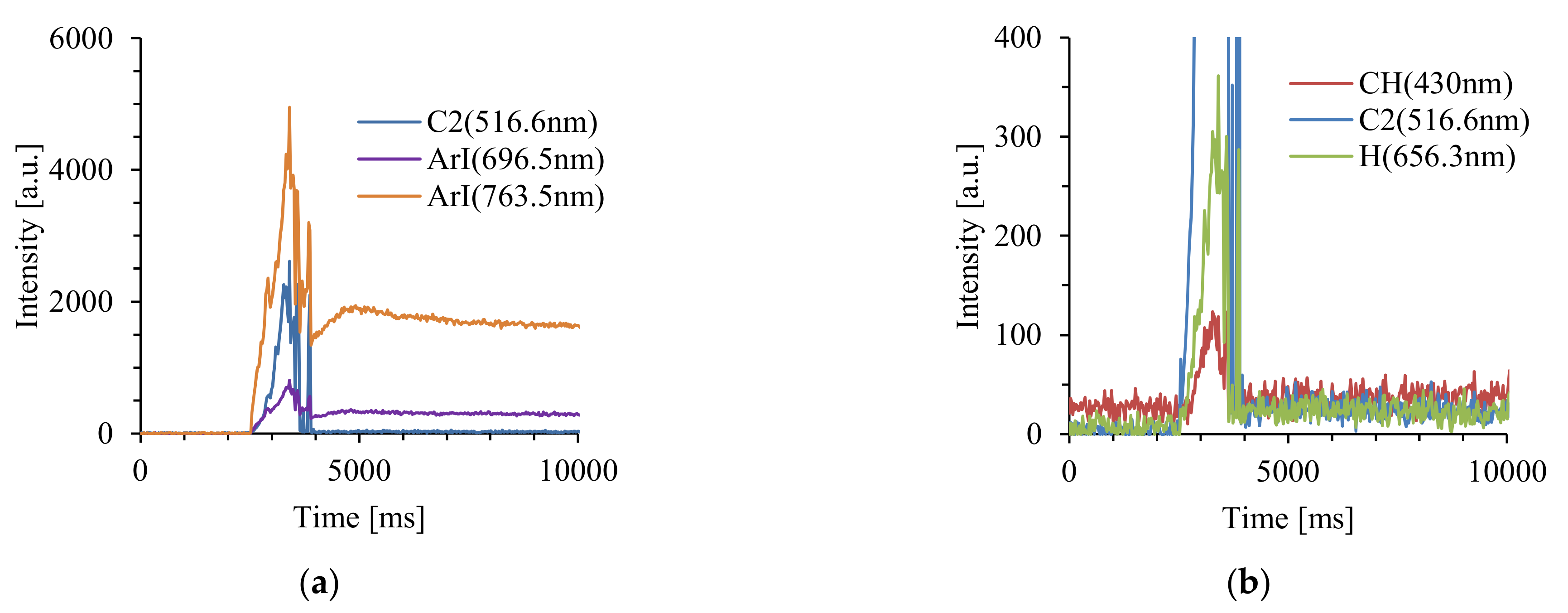
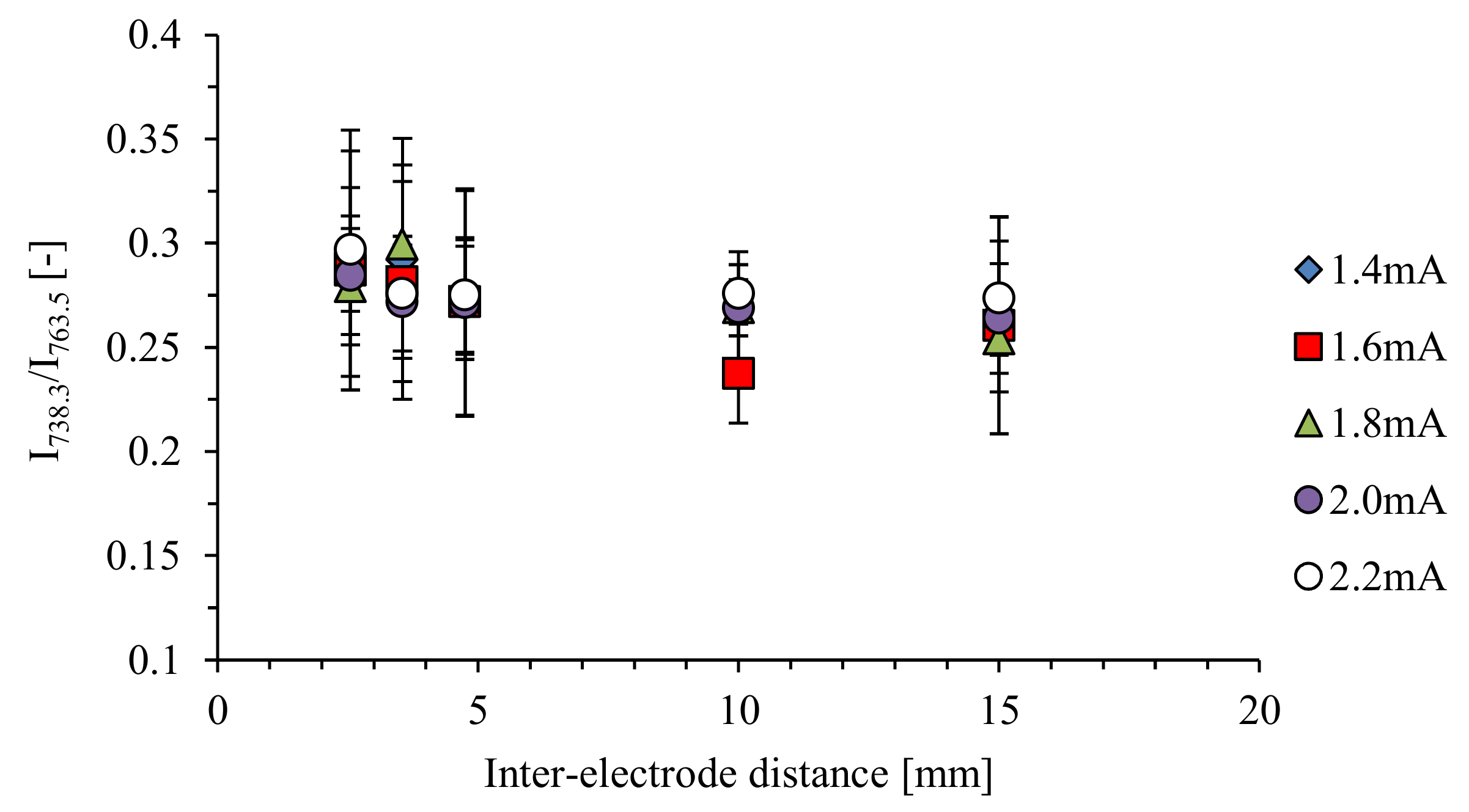
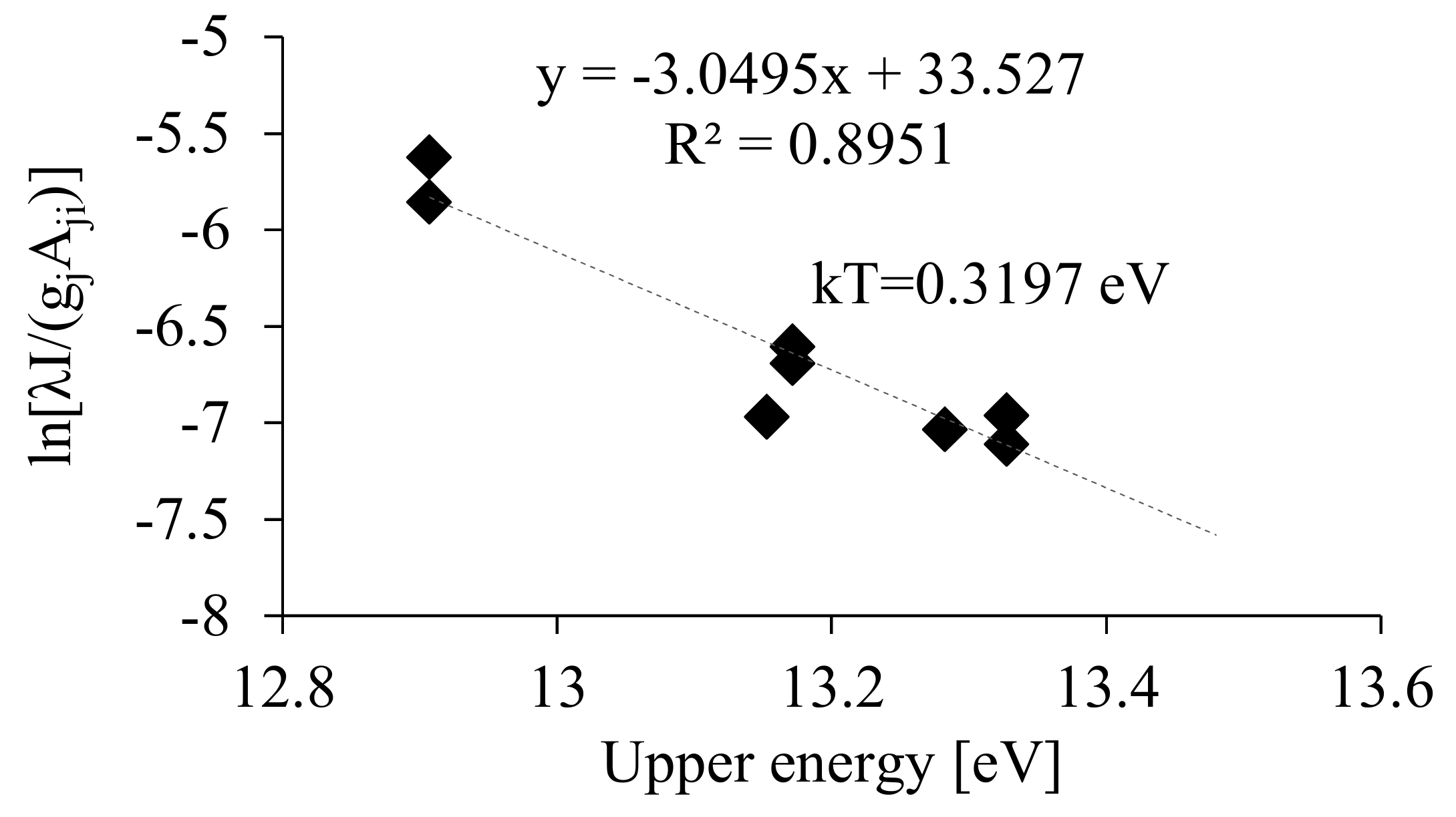

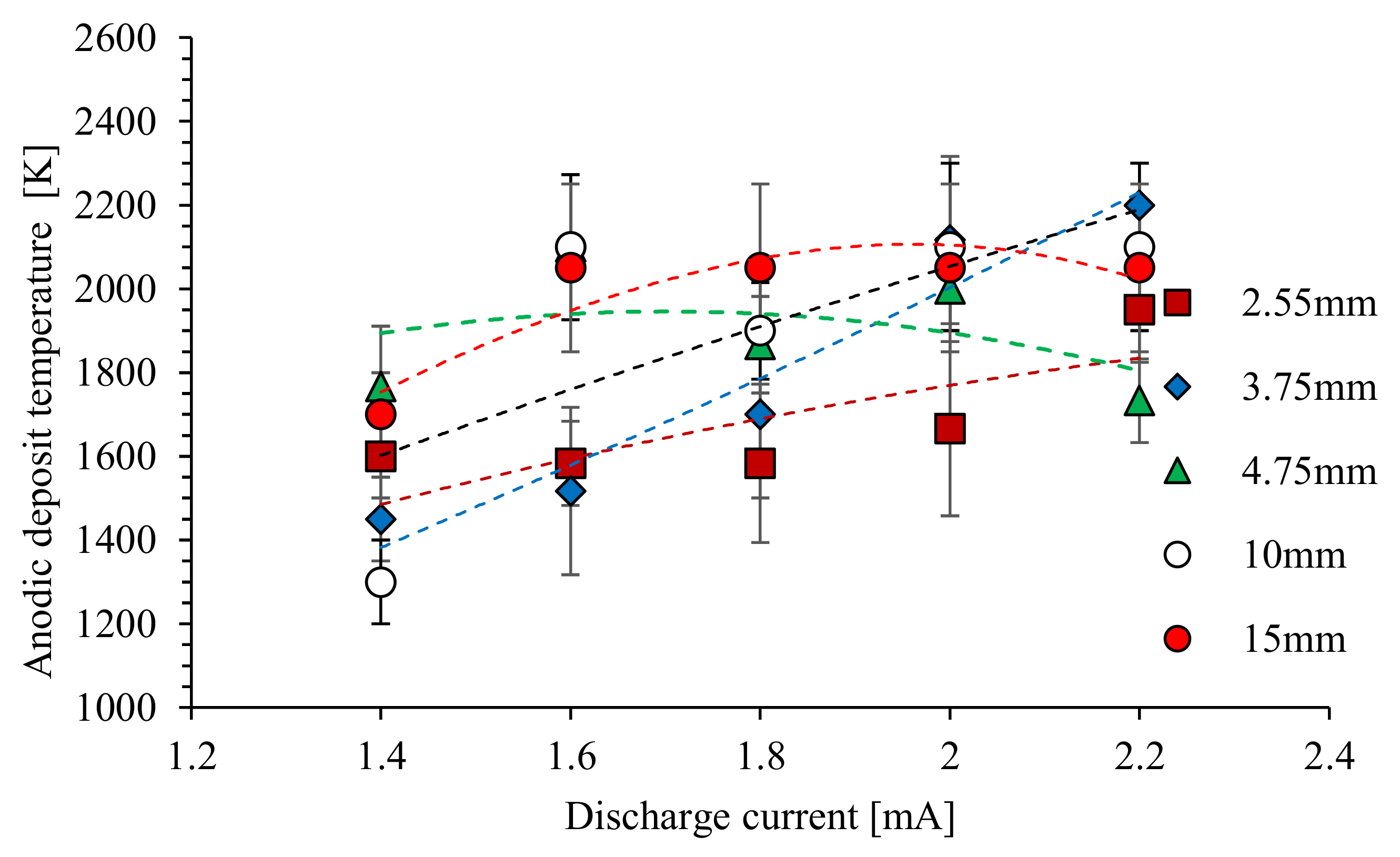
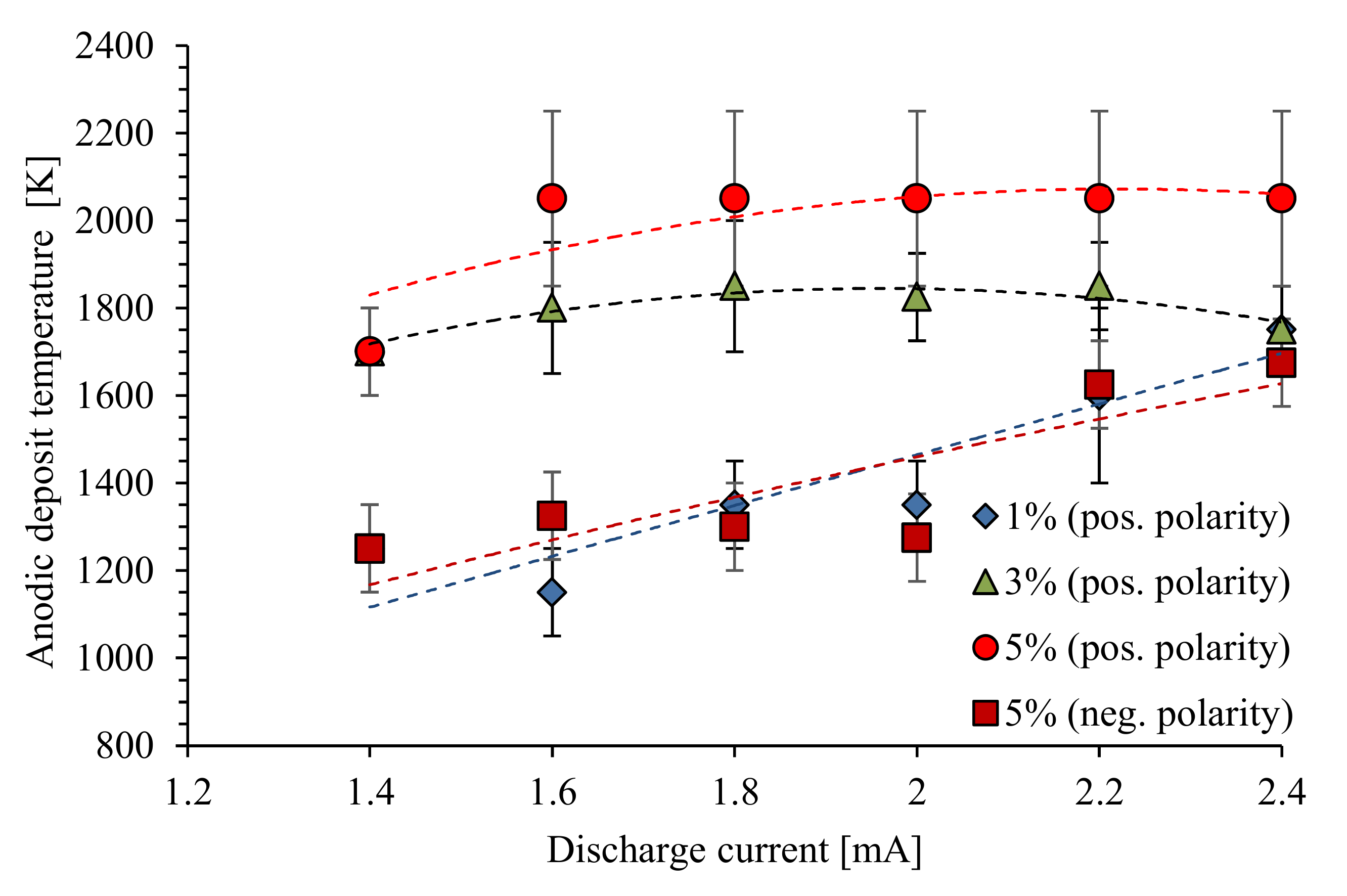
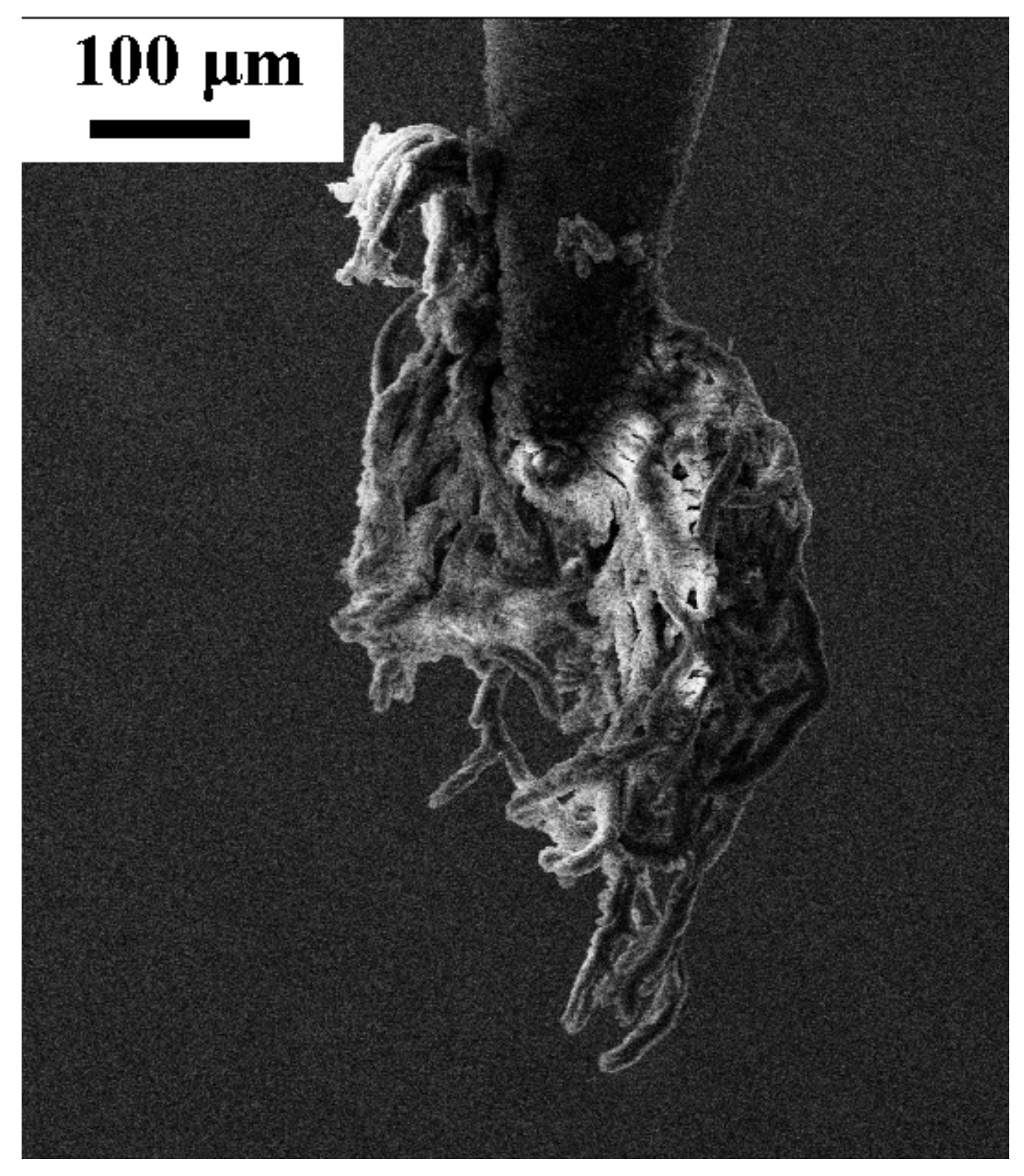
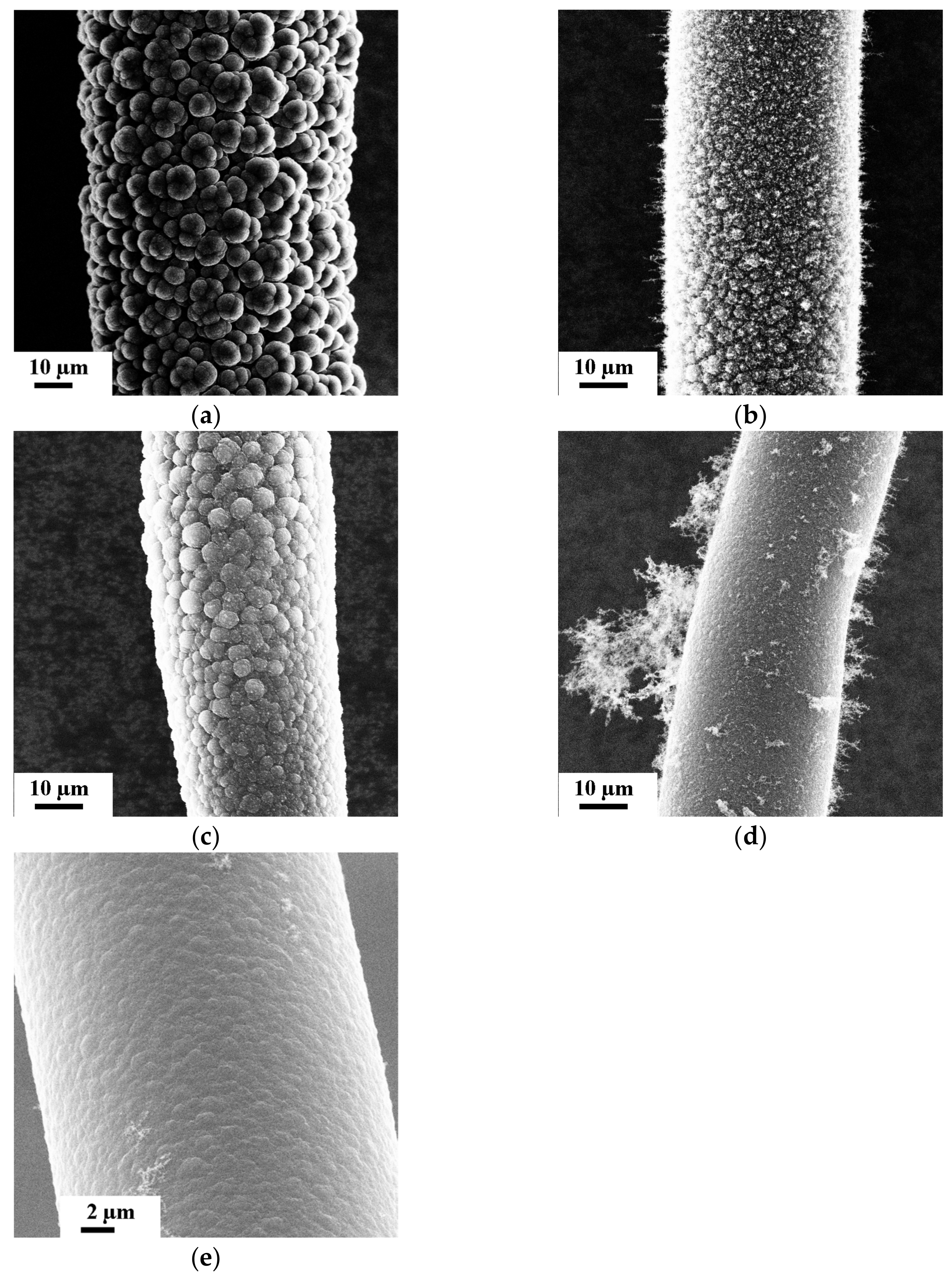
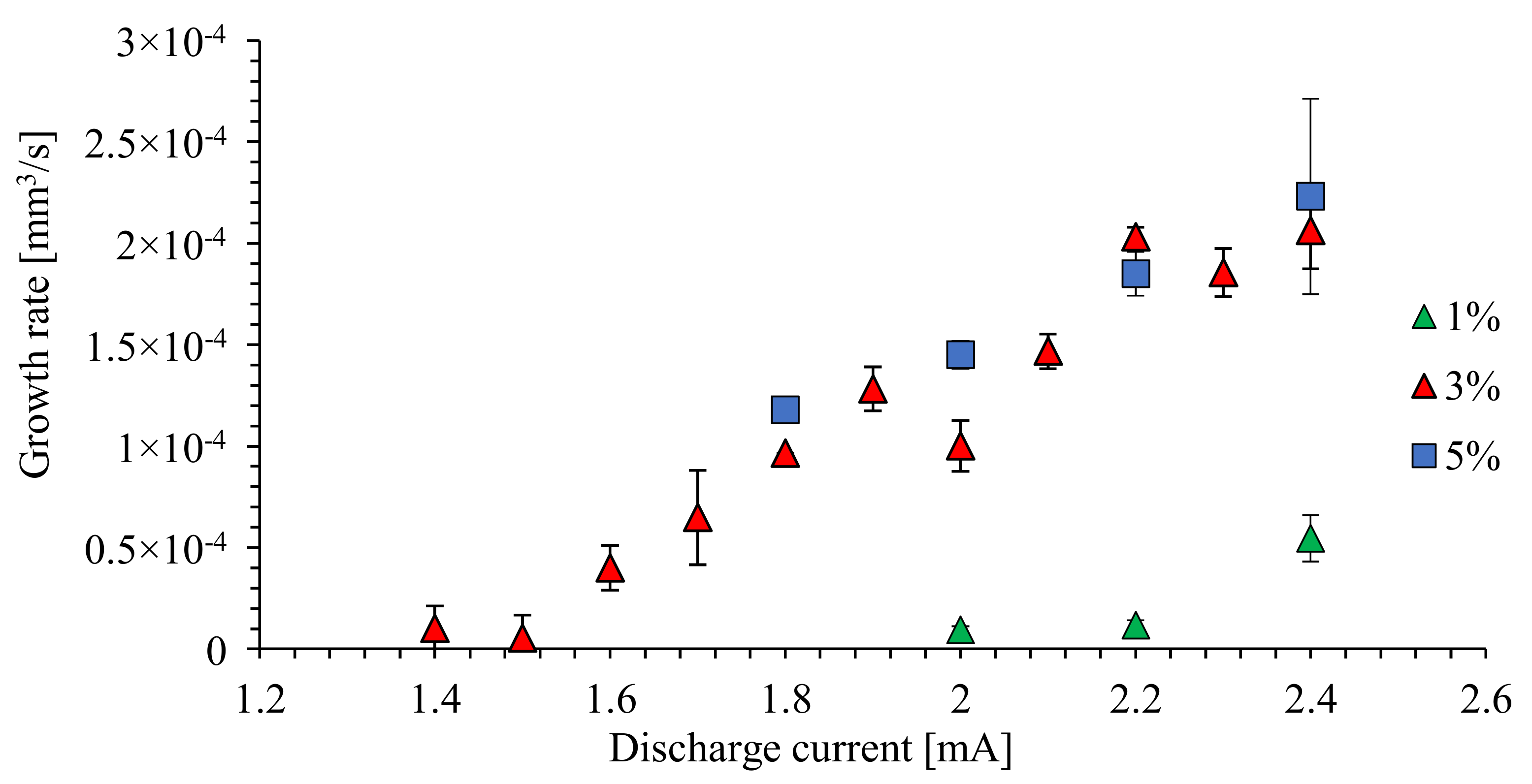
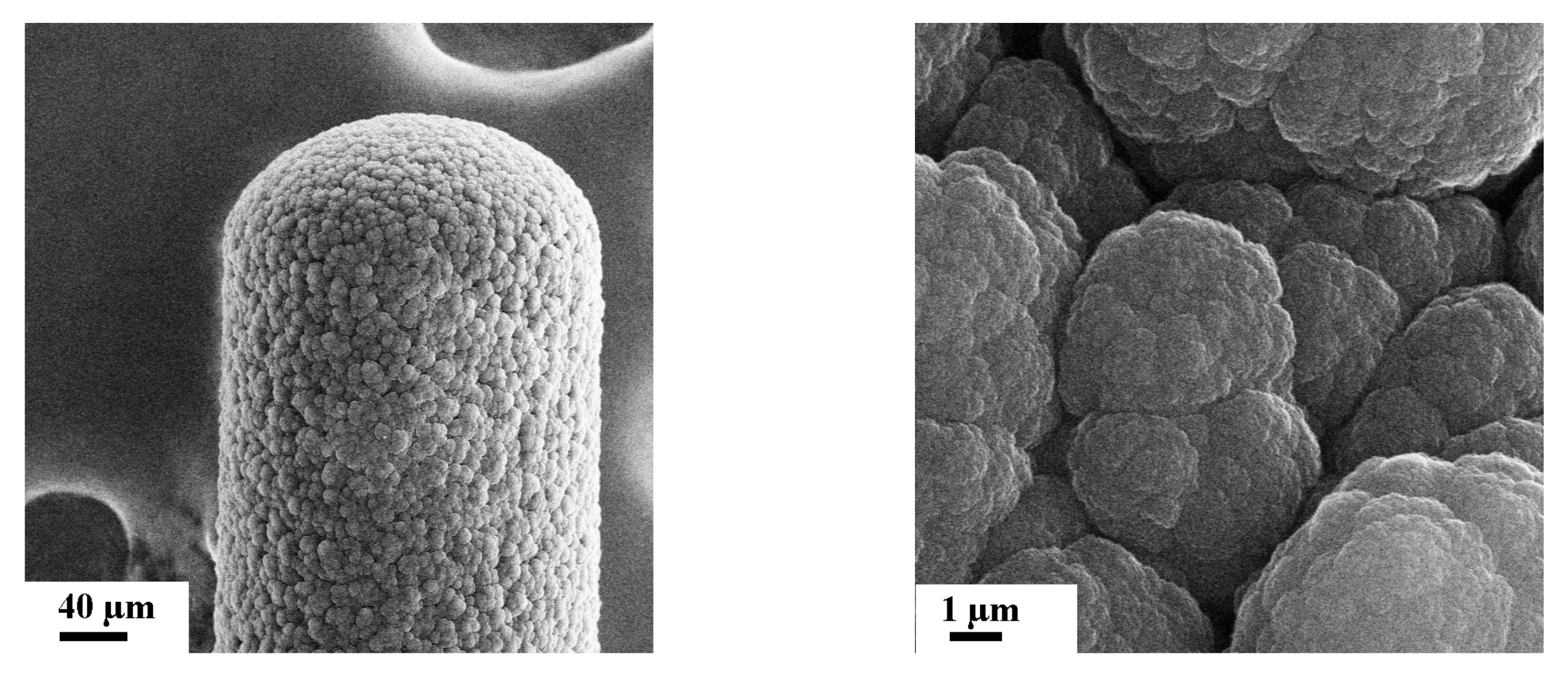
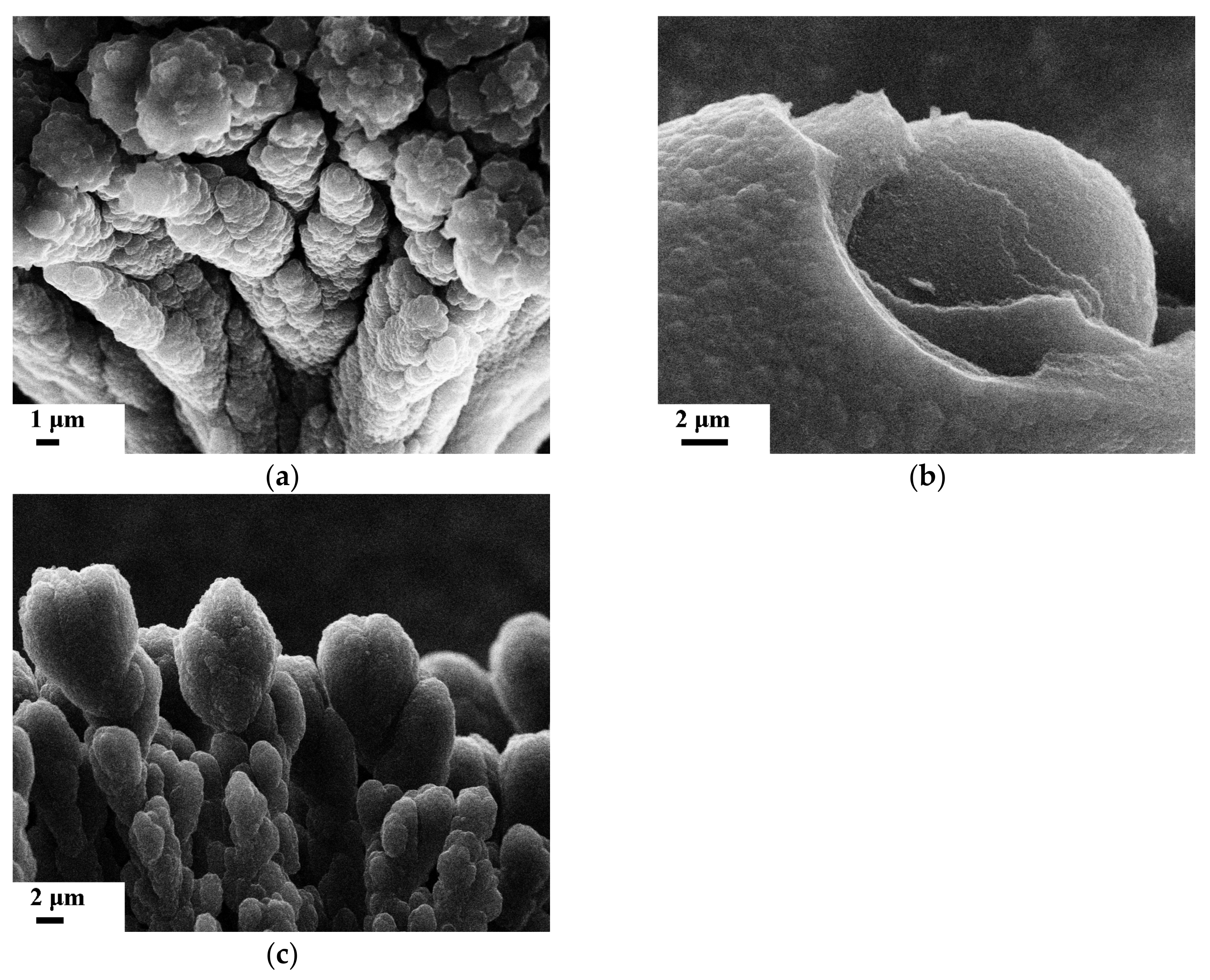
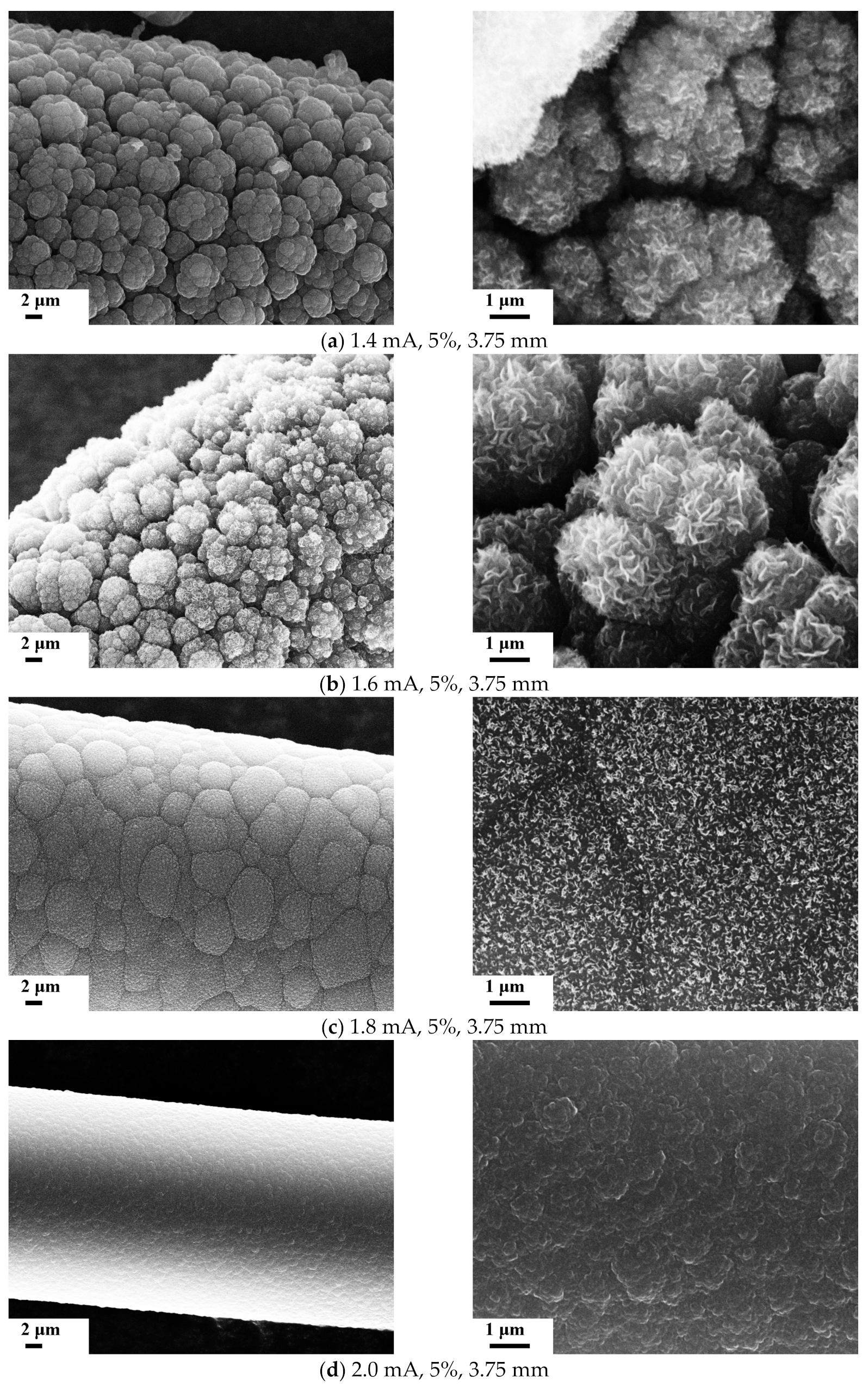
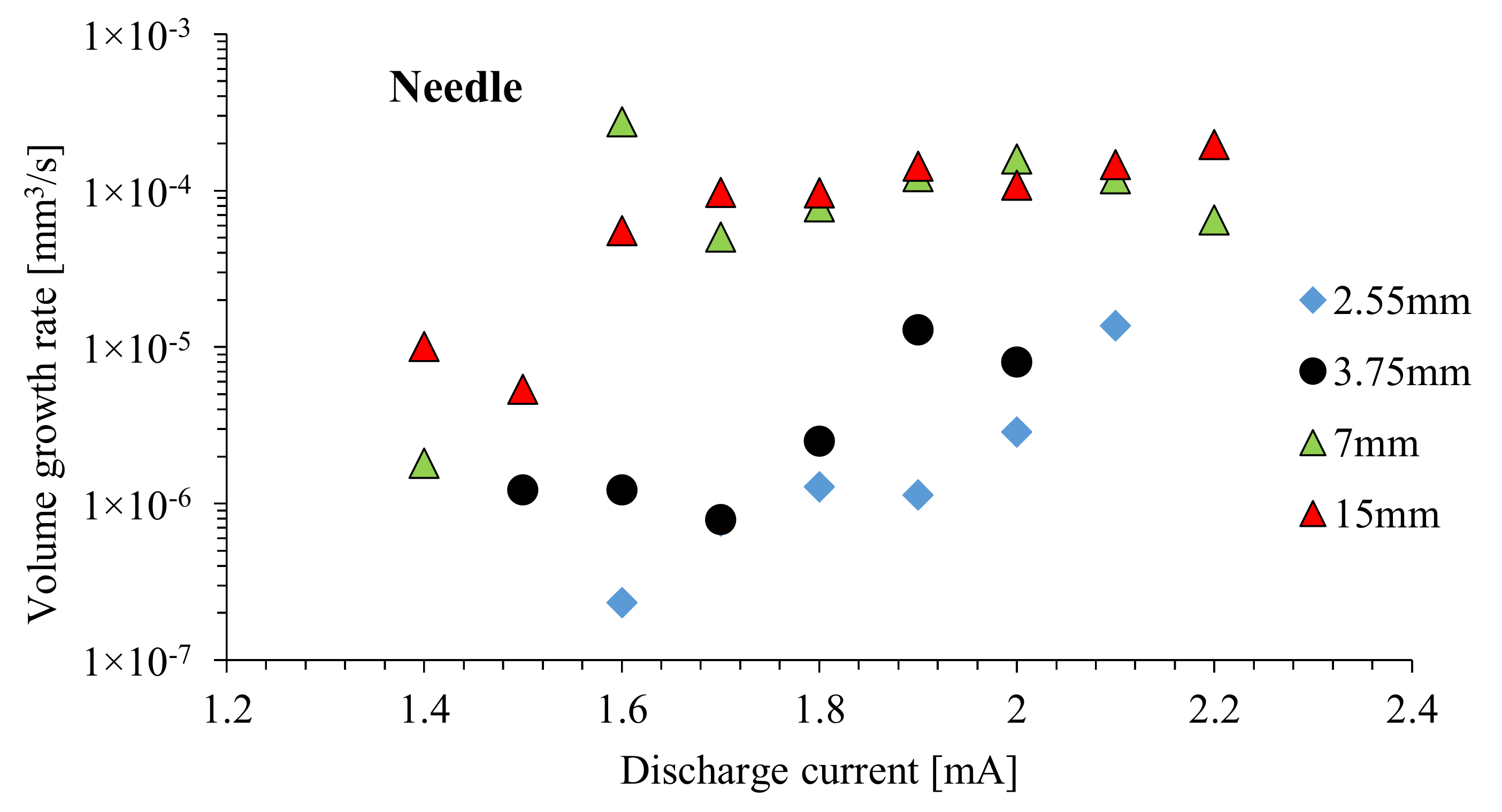
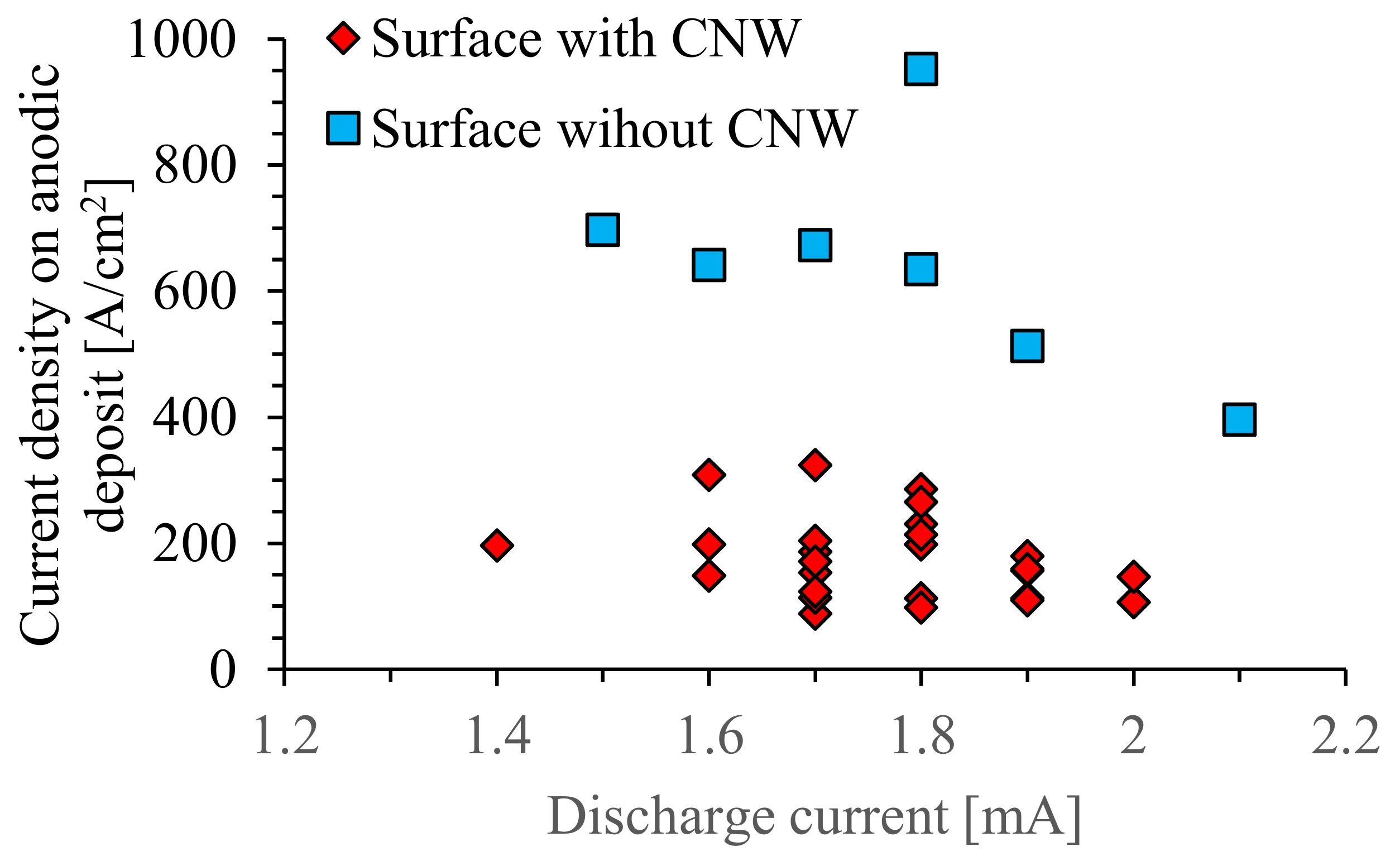
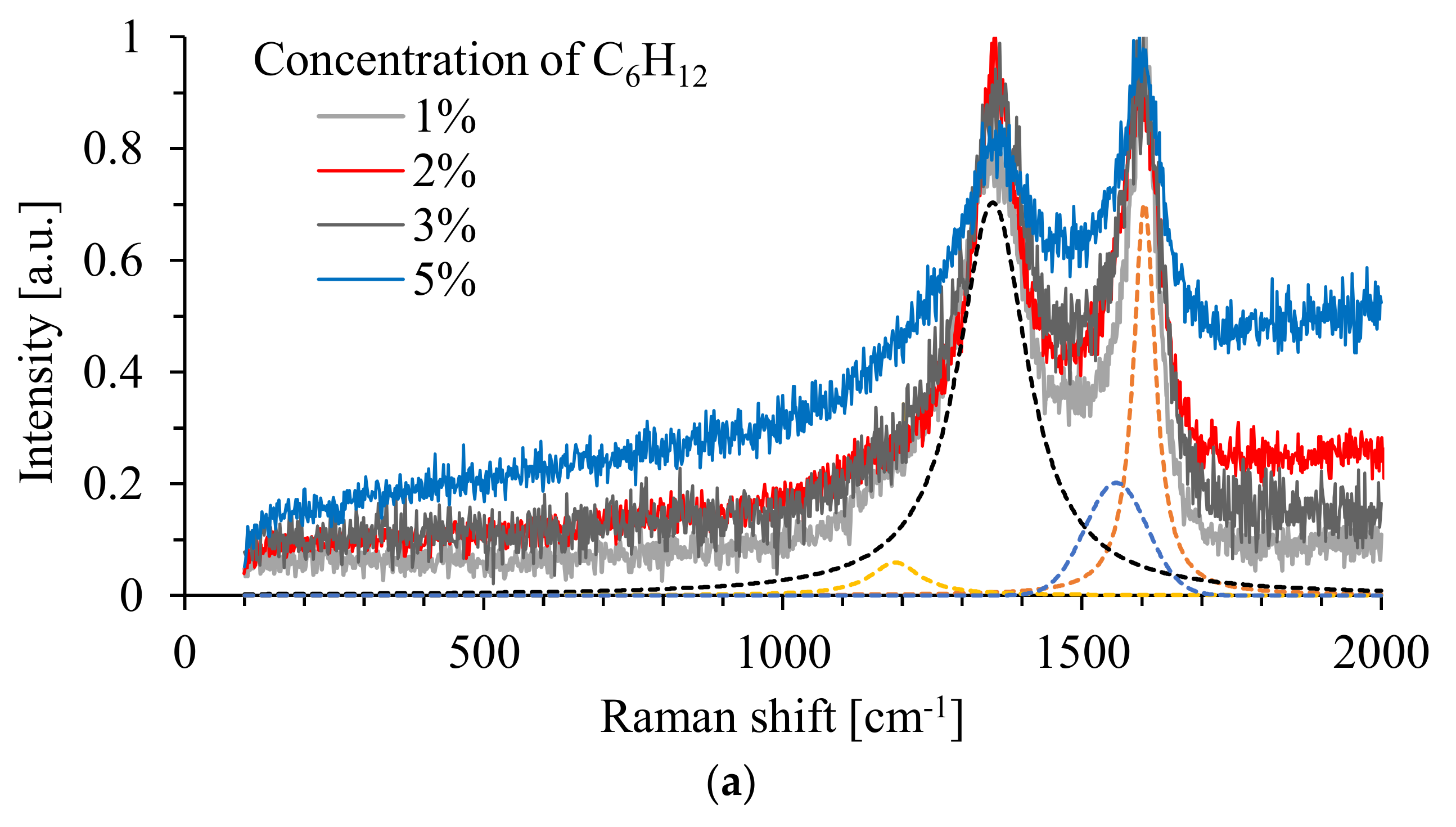
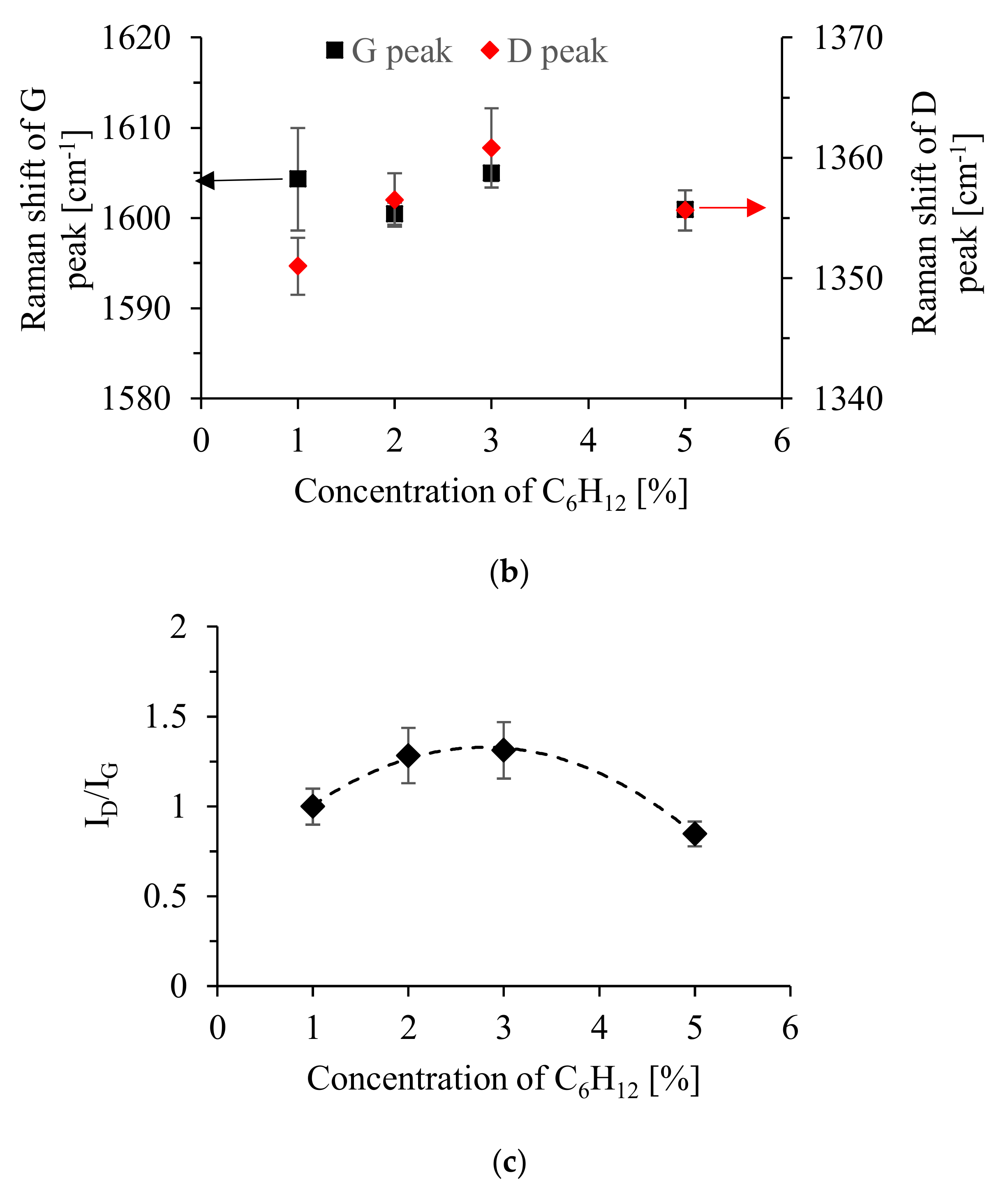
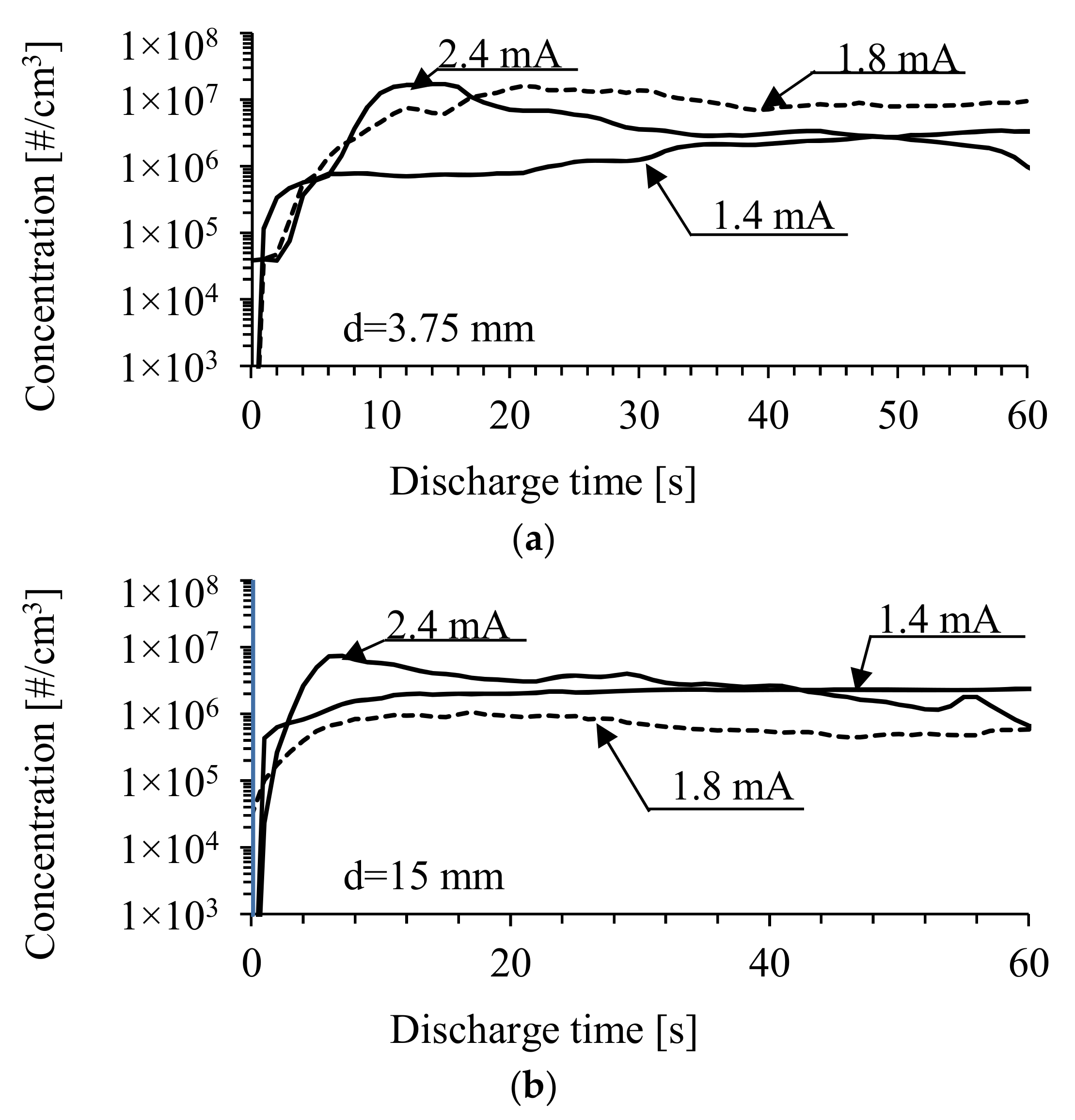
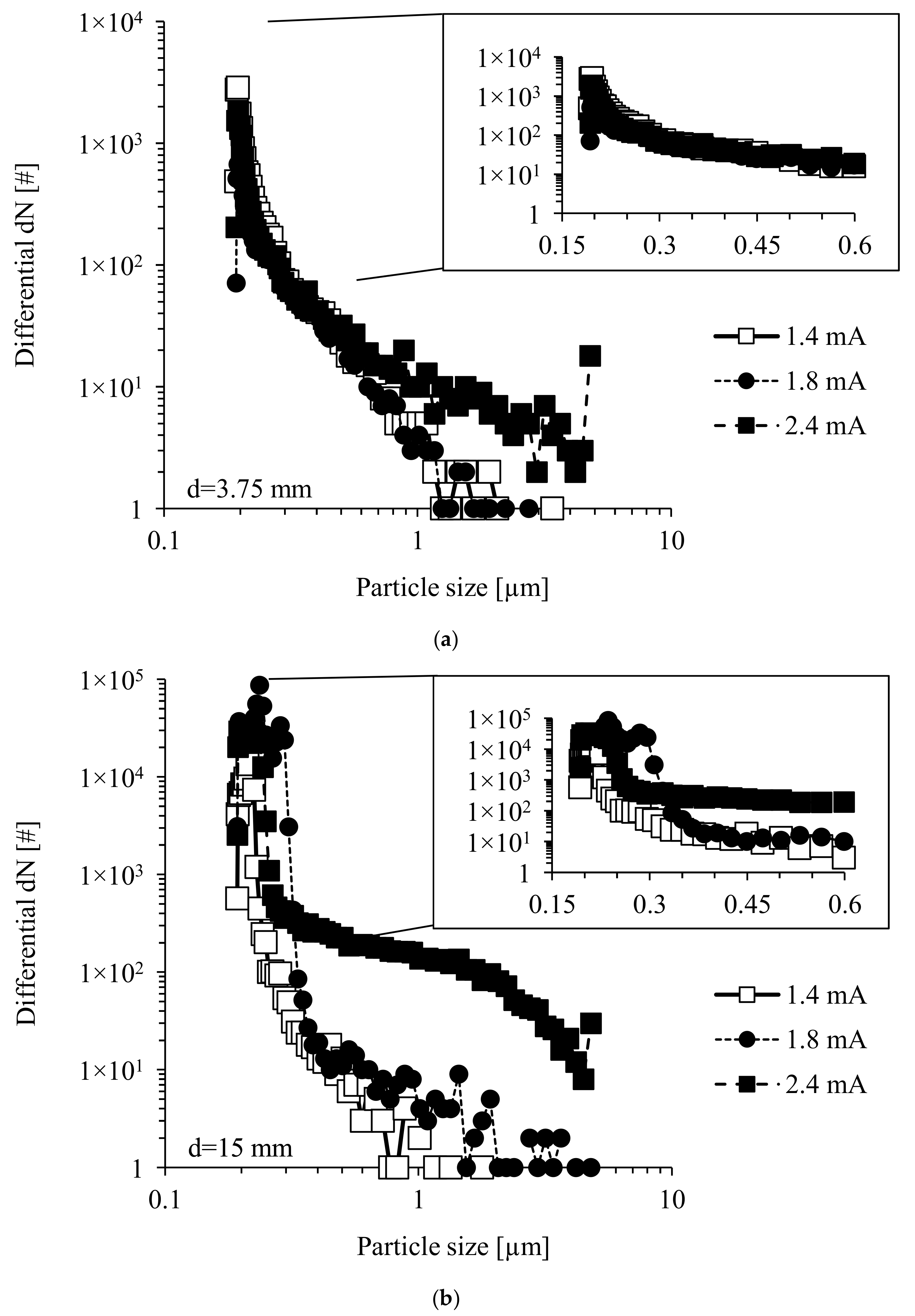
| Transition (Upper Level Energy—Lower Level Energy [eV]) | Position [nm] |
|---|---|
| 3s23p5(2P°1/2)4p →3s23p5(2P°3/2)4s (13.328–11.548) | 696.5 |
| 3s23p5(2P°1/2)4p →3s23p5(2P°3/2)4s (13.328–11.624) | 727.3 |
| 3s23p5(2P°1/2)4p →3s23p5(2P°3/2)4s (13.302–11.624) | 738.4 |
| 3s23p5(2P°3/2)4p →3s23p5(2P°3/2)4s (13.171–11.548) | 763.5 |
| 3s23p5(2P°1/2)4p →3s23p5(2P°1/2)4s (13.283–11.723) | 794.8 |
| 3s23p5(2P°1/2)4p →3s23p5(2P°1/2)4s (13.328–11.828) | 826.5 |
| 3s23p5(2P°1/2)4p →3s23p5(2P°3/2)4s (13.153–11.723) | 866.8 |
| 3s23p5(2P°3/2)4p →3s23p5(2P°3/2)4s (12.907–11.548) | 912.3 |
| 3s23p5(2P°3/2)4p →3s23p5(2P°1/2)4s (13.172–11.828) | 922.5 |
| 3s23p5(2P°3/2)4p →3s23p5(2P°3/2)4s (12.907–11.624) | 965.8 |
| Species | System | Transition | Wavelength [nm] |
|---|---|---|---|
| C2 | Swan system | A3Π→X3Π, ground state | 438–619 |
| CH | 4300 Å | A2Δ→X2Π, ground state | 430 |
| H | Balmer series | 3→2 | 656.3 |
Publisher’s Note: MDPI stays neutral with regard to jurisdictional claims in published maps and institutional affiliations. |
© 2021 by the authors. Licensee MDPI, Basel, Switzerland. This article is an open access article distributed under the terms and conditions of the Creative Commons Attribution (CC BY) license (https://creativecommons.org/licenses/by/4.0/).
Share and Cite
Sobczyk, A.T.; Jaworek, A. Carbon Microstructures Synthesis in Low Temperature Plasma Generated by Microdischarges. Appl. Sci. 2021, 11, 5845. https://doi.org/10.3390/app11135845
Sobczyk AT, Jaworek A. Carbon Microstructures Synthesis in Low Temperature Plasma Generated by Microdischarges. Applied Sciences. 2021; 11(13):5845. https://doi.org/10.3390/app11135845
Chicago/Turabian StyleSobczyk, Arkadiusz T., and Anatol Jaworek. 2021. "Carbon Microstructures Synthesis in Low Temperature Plasma Generated by Microdischarges" Applied Sciences 11, no. 13: 5845. https://doi.org/10.3390/app11135845
APA StyleSobczyk, A. T., & Jaworek, A. (2021). Carbon Microstructures Synthesis in Low Temperature Plasma Generated by Microdischarges. Applied Sciences, 11(13), 5845. https://doi.org/10.3390/app11135845





